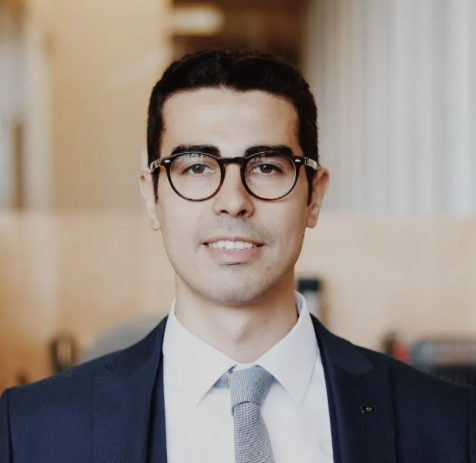Nova Scotia sets sail on a new course to support research that benefits communities
Nova Scotia has embarked on an innovative way to support research in service of society, aimed at achieving real-world outcomes for the province’s residents.
Research Nova Scotia, through its recently launched Focused Research Investments (FRI) program, has awarded $27 million to four community-focused and community-driven projects aimed at finding lasting solutions to some of the province’s biggest problems.
 “You start with a problem or a risk or an opportunity in society, and then you build a research program to solve for it,” Stefan Leslie (photo at right), CEO of Research Nova Scotia, the province’s research funding agency, said during the funding announcement.
“You start with a problem or a risk or an opportunity in society, and then you build a research program to solve for it,” Stefan Leslie (photo at right), CEO of Research Nova Scotia, the province’s research funding agency, said during the funding announcement.
In soliciting ideas for FRI projects, researchers in Nova Scotia were invited to work directly with their communities and their partners in the private and public sectors to identify communities’ needs and problems and understand what’s needed to achieve solutions.
“A true dialogue was fostered, and collectively, they are now a team,” Leslie said.
Research Nova Scotia received 46 project ideas from researchers. Of these, the research agency chose nine research teams to develop “strong, ambitious and focused programs of work.”
Of these nine, four research teams and their projects were selected as the inaugural group to be supported through the FRI program.
All four teams and projects were independently evaluated in a comprehensive review by subject matter experts around the world, Leslie said. “There is no compromise on scientific quality.”
Research Nova Scotia is confident all four teams meet the highest standards of research practices that safeguard scientific integrity and ethical standards, he said. “Although the objective may be societal benefit, research excellence is – as always – a condition of our support.”
In tackling complex problems and opportunities, each of the four teams has “identified a series of interlocking projects and initiatives within that FRI [project] that together will lead to solutions,” Leslie said.
Each FRI project is tackling a challenge where organization and coordination are required to shape and structure the research efforts and avoid duplication or inefficiencies.
Not only is the research in all four projects centred on societal needs, “We’ve identified research teams where it is the research itself that is an essential component to achieving the solution,” Leslie said.
“We need research in order to discover. We need to discover in order to learn. And we need to learn in order to solve.”
Leslie pointed out that a good investment is one where the future benefits or values exceed the costs of the investment. These costs include not only the funding Research Nova Scotia is using to support the initial four FRI projects but also the costs that all Nova Scotians pay every day that a significant, urgent societal problem is not addressed.
“We have worked in partnership with all of these teams and their communities to articulate the benefits of solving these problems,” Leslie said. “We have chosen areas where the impact will be substantial.”
Improving the well-being of aging rural Nova Scotians
Research Nova Scotia provided $12.4 million to an FRI project titled Homeward Bound: Enhancing Healthcare, Housing, and Social Support for Aging Rural Nova Scotians, led by Cape Breton University. It is the largest research award in the university’s history.
Project lead Dr. Alison Grittner, assistant professor of social work at Cape Breton University, will lead a diverse team of community, academic, industry and research experts to bring innovative health care, housing and social supports to aging Nova Scotians in rural communities.
Project collaborators include institutions across Nova Scotia, New Brunswick and Ontario, as well as community collaborators and advisors who helped develop the team’s project.
Dr. Olga Theou, Canada Research Chair in Physical Activity, Mobility and Healthy Aging, and Dr. Kenneth Rockwood, an internationally recognized geriatrician, along with their team at Nova Scotia Health, will integrate frailty research into the Homeward Bound project.
In 2024, 22 percent of Nova Scotia’s population was 65 or older, surpassing the national average of 19 percent.
That percentage is even higher – about 30 percent – in the province’s Eastern Health Zone, where the project will take place, Grittner said.
Studies show most aging Nova Scotians want to remain in their homes and communities. But they face challenges such as geographic isolation from neighbours and health care, inaccessible housing stock and disconnected social supports – all barriers to aging well.
Most vulnerable are women, who age with significantly higher rates of disability, income precarity, and access to health care.
“I hold this knowledge of how difficult those challenges are,” Grittner said. “As one of my own grandmothers was facing them, she chose to end her life instead of face the difficulty that comes with these experiences.”
The Homeward Bound project partners will collaborate with aging rural Nova Scotians in the Eastern Health Zone to design, implement and evaluate interventions across health care, housing and social supports.
“We will assess how appropriate housing can help seniors stay in their homes,” Grittner said.
The project also will introduce virtual care, surgical transition support, prehabilitation initiatives and a community handyperson initiative that will facilitate home repairs, adaptations and maintenance required for aging in place.
“Our community navigators and mobile research vans will ensure that seniors remain connected to the research project, the social programs, and most importantly, their communities,” Grittner said.
Homeward Bound also includes a community navigator program that will connect aging rural Nova Scotians to community resources to improve health outcomes, provide systems navigation support, and co-create opportunities that enhance social connection.
The project, which will develop an “Aging in the Right Place” model for rural communities, will reduce hospital visits, delay or prevent long-term care admissions, “and most importantly, enhance the quality of life for aging rural Nova Scotians and beyond,” Grittner said.
Incorporating Indigenous Knowledge and research in health and wellness
Research Nova Scotia provided $7 million to another FRI project titled Etuaptmu'k W'loti: Using Mi'kmaw Knowledge to Create Health & Wellness Solutions.
The project is led by John R. Sylliboy, a member of Millbrook and Eskasoni First Nations, and Dr. Margot Latimer, professor and Indigenous Health Chair in Nursing at Dalhousie University and IWK Health.
Project partners include Tajikeimɨk and the Wije'winen Health Centre, Nova Scotia Health, the Wabanaki Two-Spirit Alliance, the Wabanaki-Labrador Network, Hearing & Speech Nova Scotia, the Nova Scotia Departments of Health & Wellness and Advanced Education, Mi'kmaw Kina'matnewey, and Accreditation Canada.
“The important thing about the FRI, we feel, is that this is going to be a significant validation of Nationhood-based research as the Mi’kmaq in Mi’kma’ki,” said Sylliboy, executive director of the Wabanaki Two-Spirit Alliance.
Mi’kma’ki, or the Mi’kmaq traditional territory, encompasses all the Atlantic provinces and extends into Maine in the U.S. All of Mi’kma’ki will be included in the FRI project.
The project will develop care and service solutions based on Mi’kmaq communities’ interpretation of their own health utilization data. This includes improving access to culturally safe health, healing and education experiences for Mi’kmaw (which means individuals) children and youth.
The project also includes creating a Mi'kmaw-developed and validated “Cultural Safety in Healthcare” indicators toolkit for health organizations and providers to measure, document and enhance cultural safety.
Optimizing mental health care programs for Nova Scotian youth
Research Nova Scotia awarded $6.5 million to a third FRI project titled Unifying Networks to InnovaTE (UNITE): A Whole of System Approach for Youth Mental Health.
UNITE brings together an interdisciplinary team of more than 40 members and 20 partner organizations, including decision-makers, youth and community advocates.
The project is led by Dr. Jenny Baechler, senior instructor in the Faculty of Management at Dalhousie University; Dr. Jill Chorney, scientific lead for mental health and addictions at IWK Health and associate professor of psychiatry at Dalhousie University; and Dr. Lori Wozney, Sun Life Chair in Youth Mental Health at Dalhousie University and IWK Health and assistant professor of psychiatry at Dalhousie.
The project’s focus includes optimizing current efforts in navigation so that youth, their families and those working with them have a more supportive, compassionate and efficient experience as they find their way to care.
“We’re going to trial different solutions with those youth and caregivers and with the different kinds of providers that they intersect with across the system,” Wozney said.
“It’s really important that those moments of help-seeking and reaching out are met with care that’s very humanizing and compassionate and supportive.”
Another focus of the project is on data. “We all have a lot of data, but we don’t always know what to do with it and take good insights out of that data,” Wozney said.
“Part of our work is going to be ‘How do we work together as a team to get better insights out of our data so that we understand more about what’s happening with our youth, their needs [and] the services that they need?’”
The project also will improve the capacity for people and groups who work in complex systems to undertake innovations together more effectively.
The aim is to equip individuals and organizations across the youth care system with better skills, knowledge and tools to work across boundaries effectively, despite sometimes competing and shifting priorities and mandates.
“We know that as we do this work, we’re going to improve the lives of young people and really work towards building a better future together,” Wozney said.
Putting communities at the heart of problem-solving
The fourth FRI project, which received $1 million from Research Nova Scotia, is titled Creating Integrated Restorative Communities for Locally Engaged Solutions (CIRCLES-NS).
As part of the project, Jennifer Llewellyn, director of the Restorative Research, Education and Innovation Lab at Dalhousie University’s Schulich School of Law, and the CIRCLES-NS team will establish “living labs” – which put communities at the heart of problem solving.
These labs will take a restorative approach in bringing people together to identify their local priority issues, the key questions and challenges they need to conduct real-world experiments based on the best evidence, and how to use what they learn to find solutions and lasting pathways to well-being and success.
The initial phase of the project will bring together community-based teams from across Nova Scotia to design and test a living lab model to support the development and work of restorative communities, Llewellyn said.
“Our project is designed to try to redefine an approach to research as something that’s not done to communities or even simply for their benefit, but that’s done with them and by them and as a pathway of collective learning and action that’s needed for lasting social impact.”
The first living lab test site will start in the Valley Region with the focus on their chosen priority issue around community safety, Llewellyn said.
“Through this work, we’re not just addressing these current problems,” she noted. “We’re focused on establishing the conditions so the communities can become and renew their ability to be problem solvers, now and into the future.”
Research Nova Scotia’s Leslie, in his opening remarks, cited a 2016 article, “Saving Science,” in The New Atlantis by Daniel Sarewitz, professor of science and society at Arizona State University.
Sarewitz wrote that the most valuable science institutions in the future will be closely linked to the people and places whose urgent problems need to be solved. These institutions will cultivate strong lines of accountability to those for whom solutions are important. They will incentivize scientists to care about the problems more than the production of knowledge.
Sarewitz also said these institutions will link research agendas to the quest for improved solutions – often technological ones – rather than understanding for its own sake.
The science these institutions produce will be of higher quality “because it has to be,” Sarewitz said. “Only through direct engagement with the real world can science free itself to rediscover the path toward truth.”
See also: Nova Scotia launches program to fund interdisciplinary research driven by societal outcomes
R$
| Organizations: | |
| People: | |
| Topics: |
Events For Leaders in
Science, Tech, Innovation, and Policy
Discuss and learn from those in the know at our virtual and in-person events.
See Upcoming Events
You have 0 free articles remaining.
Don't miss out - start your free trial today.
Start your FREE trial Already a member? Log in
By using this website, you agree to our use of cookies. We use cookies to provide you with a great experience and to help our website run effectively in accordance with our Privacy Policy and Terms of Service.





